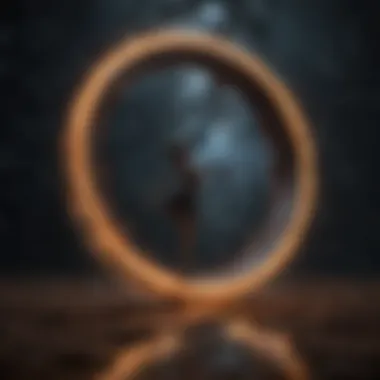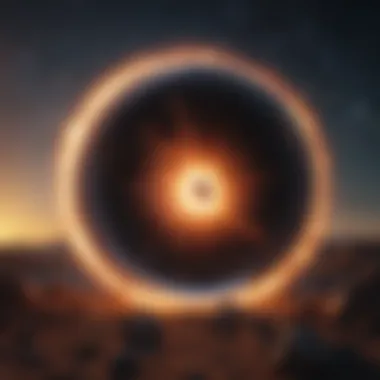Unveiling the Intricacies of Black Hole Formation in Cosmic Realms


Nature Topic Overview
In the vast expanse of the cosmos, a remarkable phenomenon unfolds - the formation of black holes. It is a journey that begins with the evolution of massive stars, those colossal celestial bodies that illuminate the night sky with their brilliance. Through a mesmerizing cascade of events, these stars exhaust their nuclear fuel, leading to a gravitational collapse of unparalleled magnitude. This collapse marks the genesis of a black hole, a region in space where gravity is so intense that nothing, not even light, can escape its grasp. The intricate dance of forces and energies involved in this process unveils a cosmic spectacle that challenges our understanding of the universe.
Introduction to Black Holes
In this compelling exploration of cosmic phenomena, the section on Introduction to Black Holes serves as a crucial foundation for unraveling the mysteries of these enigmatic entities. By delving into the fundamental concepts surrounding black holes, readers are primed to grasp the intricate interplay of forces governing their formation. Through a meticulous examination of the characteristics and behavior of black holes, this section sets the stage for a deeper investigation into their origins and implications within the cosmic landscape.
What is a Black Hole?
A black hole is a cosmic entity characterized by its incredibly dense mass, compact size, and powerful gravitational pull that not even light can escape from its grasp. Essentially, a black hole represents a region in space where the gravitational forces are so intense that they result in the collapse of massive stars or other celestial bodies into a singular point of infinite density known as a singularity. This phenomenon creates a gravitational field so strong that it distorts space-time itself, profoundly influencing the surrounding cosmic environment and challenging our understanding of the universe's physical laws.
Significance of Studying Black Holes
The study of black holes holds profound significance in expanding our knowledge of the universe and its underlying principles. By probing the intricate complexities of black holes, scientists can gain valuable insights into theoretical physics, the behavior of gravity under extreme conditions, and the dynamics of massive celestial bodies. Furthermore, understanding black holes enables us to explore concepts such as space-time curvature, event horizons, and the cosmic implications of these fascinating entities. Through the study of black holes, researchers can also delve into cutting-edge areas of astrophysics, pushing the boundaries of human understanding and paving the way for groundbreaking discoveries in the realms of space exploration and theoretical physics.
Stellar Evolution: The Birth of Massive Stars


Formation of Massive Stars
As we delve into the formation of massive stars, we uncover a mesmerizing tale of gravitational collapse and protostellar evolution. Massive stars, unlike their smaller counterparts, emerge from vast clouds of dust and gas through a series of complex events that culminate in the ignition of nuclear fusion, the fiery heartbeat that sustains these stellar behemoths. The interplay of gravity, pressure, and temperature orchestrates this cosmic symphony, shaping massive stars into luminous entities that illuminate the cosmos with their brilliance.
Life Cycle of Massive Stars
The life cycle of massive stars unfolds as a cosmic journey fraught with drama and spectacle. From their fiery inception to the inevitable culmination in a dazzling supernova explosion, massive stars navigate a tumultuous path defined by intense nuclear reactions and gravitational forces. Throughout this cycle, these celestial titans forge heavy elements essential for the diversity of the universe, enriching the cosmic tapestry with their stellar alchemy.
Supernova: The Spectacular Demise
The supernova represents the grand finale in the life of a massive star, a cataclysmic event that reverberates across the cosmos with awe-inspiring intensity. In a spectacular display of destruction and creation, the dying star unleashes a burst of energy that rivals the brightness of entire galaxies, scattering elements forged in its core far and wide. This explosive finale marks the transition from stellar brilliance to the enigmatic realm of black holes, setting the stage for the birth of cosmic anomalies that continue to captivate and perplex astronomers worldwide.
Gravitational Collapse: When Stars Collapse Inward
In delving into the intricate narrative of black hole formation, the section on Gravitational Collapse: When Stars Collapse Inward holds a pivotal role. It serves as a critical juncture in the cosmic journey towards the creation of these enigmatic entities. The gravitational collapse of massive stars under the weight of their own gravity leads to a phenomenon of immense significance in astrophysics. This process signals the beginning of the end for a star's life, culminating in the formation of a black hole, a region of spacetime exhibiting gravitational pull so strong that not even light can escape. Gravitational Collapse opens a gateway to the mysteries of the universe, offering a profound insight into the evolution of celestial bodies and the fundamental forces shaping our cosmos.
The Role of Gravity in Star Collapse


The intricate dance of gravity plays a central role in the dramatic spectacle of a star's collapse. As a massive star reaches the end of its life cycle, the force of gravity overpowers the outward pressure generated by nuclear fusion at its core. This imbalance triggers a catastrophic collapse, compressing the star's core with immense force. Gravity acts as the silent conductor orchestrating this cosmic symphony, guiding the transition of a luminous star into a dense, dark entity. Understanding the role of gravity in star collapse unveils the profound mechanisms governing the fate of stars and sets the stage for the emergence of black holes.
Formation of Singularity: Infinite Density Point
At the heart of a black hole lies the enigmatic concept of a singularity: a point of infinite density where the laws of physics, as we know them, cease to apply. The formation of a singularity marks the culmination of gravitational collapse, where the core of a massive star undergoes a collapse to a point of infinite density. This dense core warps the fabric of spacetime, creating a gravitational well from which nothing, not even light, can escape. The singularity encapsulates the extreme nature of black holes, where conventional physics confronts its boundaries, delving into the realms of the unknown.
Event Horizon: Boundary of No Return
As the gravitational collapse progresses, a defining feature of black holes emerges: the Event Horizon. This elusive boundary, encompassing the singularity, marks the point of no return in the cosmic abyss. Once an object crosses the Event Horizon, it is destined to be consumed by the black hole, with no possibility of escape. The Event Horizon encapsulates the gravitational grip of black holes, defining the boundary between the observable universe and the mysterious realms beyond. Understanding the significance of the Event Horizon sheds light on the profound implications of black hole physics and the captivating complexities of our universe.
Types of Black Holes
In the all-encompassing exploration of the intricacies surrounding the formation of black holes, understanding the distinct classes of these cosmic enigmas is paramount. Types of Black Holes stand as a cornerstone in the narrative, delineating the varied manifestations of these gravitational behemoths. From the minuscule yet potent Primordial Black Holes to the awe-inspiring Supermassive Black Holes that dominate galactic centers, each type offers a unique insight into the cosmic tapestry. Primordial Black Holes, born from the vestiges of the early universe, present a fascinating window into the conditions of primordial cosmic soup, while Stellar Black Holes showcase the remnants of massive stars that have met their cataclysmic end. Supermassive Black Holes, lurking at the cores of galaxies, wield immense gravitational influence shaping the very fabric of the cosmos. Exploring the Types of Black Holes unveils a spectrum of cosmic possibilities, each contributing distinctively to our understanding of the universe.
Primordial Black Holes
Delving into the enigmatic realm of Primordial Black Holes unveils a narrative steeped in cosmic antiquity. These minuscule yet significant entities offer a glimpse into the infancy of the universe, arising from perturbations in the density fluctuations during the early cosmos. Primordial Black Holes, a product of the extreme conditions prevailing in the nascent universe, harbor mysteries that bridge the astronomical scales of the past with the complexities of modern cosmology. Their relevance in contemporary astrophysics lies in challenging existing models of cosmic evolution and shedding light on the elusive dark matter composition of the universe. Unraveling the enigma of Primordial Black Holes beckons us to reevaluate our cosmic origins and push the boundaries of astrophysical knowledge.


Stellar Black Holes
Within the cosmic narrative of stellar evolution, Stellar Black Holes emerge as celestial remnants of massive stars that have culminated their evolutionary journey in spectacular supernova events. These gravitational anomalies, forged from the remnants of stellar cores, exhibit an intense gravitational pull that not even light can escape. Stellar Black Holes, through their gravitational tyranny, exemplify the cosmos's ability to morph colossal stellar structures into infinitesimal yet profoundly influential entities. Studying Stellar Black Holes unravels the fate of massive stars and underscores the ephemeral nature of cosmic structures, offering a glimpse into the sublime forces governing the universe's evolution.
Supermassive Black Holes
At the cosmic epicenter of galaxy evolution lie the enigmatic Supermassive Black Holes. These gravitational behemoths, with masses millions to billions of times that of the sun, harbor immense power that governs entire galactic dynamics. Supermassive Black Holes, shrouded in the cosmic mystery of their formation and evolution, play a pivotal role in shaping galactic structures and influencing star formation rates. Their colossal presence at galactic cores signifies the intricate dance between stellar processes and cosmic phenomena, presenting a canvas where the gravitational ambitions of black holes sculpt the galactic landscape. Exploring Supermassive Black Holes illuminates the pivotal role these cosmic leviathans play in shaping the cosmic order and underscores their unparalleled significance in unraveling the mysteries of the universe.
Theoretical Concepts and Further Research
The realm of Theoretical Concepts and Further Research within the context of black hole formation delves into the fascinating intricacies of cosmic physics. By delving deep into these concepts, we unravel the underlying principles that govern the enigmatic formation of black holes. Understanding Theoretical Concepts and Further Research provides a gateway to exploring the forefront of astrophysics and theoretical cosmology. It offers a profound insight into the fundamental laws of the universe that orchestrate the creation and behavior of black holes. Engaging with Theoretical Concepts and Further Research not only enriches our comprehension of black holes but also fosters groundbreaking advancements in our cosmic knowledge.
Hawking Radiation and Black Hole Information Paradox
Hawking Radiation and the Black Hole Information Paradox present a conundrum at the heart of black hole physics. Hawking Radiation, theorized by renowned physicist Stephen Hawking, suggests that black holes emit radiation, ultimately leading to their evaporation. This phenomenon challenges established principles of black hole mechanics and entropy. On the other hand, the Black Hole Information Paradox revolves around the conservation of information and quantum principles within black holes. Resolving these paradoxes is essential in furthering our understanding of black holes and unveiling the mysteries of quantum gravity. Exploring Hawking Radiation and the Black Hole Information Paradox opens doors to revolutionary insights into the nature of spacetime and the quantum fabric of the cosmos.
String Theory and Black Hole Physics
String Theory interlaces with Black Hole Physics in a quest to unify quantum mechanics and general relativity. String Theory posits that all fundamental particles are tiny, vibrating strings, offering a potential framework to explain the behavior of black holes at a quantum level. By integrating String Theory into the realm of Black Hole Physics, scientists aspire to decode the profound connection between gravity, quantum mechanics, and the microscopic structure of the universe. Delving into String Theory and Black Hole Physics is instrumental in unraveling the mysteries lurking at the intersection of subatomic particles and cosmic phenomena.
Current Areas of Exploration and Unsolved Mysteries
Currently, the exploration of black holes brims with excitement as scientists delve into uncharted territories of the cosmos. By focusing on Current Areas of Exploration and Unsolved Mysteries, researchers aim to decipher the enigmatic nature of black holes and address fundamental questions that elude our current understanding. From the perplexing concept of black hole singularities to the evaporation process through Hawking Radiation, each aspect presents a tantalizing puzzle waiting to be solved. Through collaborative efforts and cutting-edge technologies, the scientific community endeavors to push the boundaries of knowledge and illuminate the darkest corners of the universe.







